Romance to Exemplary Wedding. Conscious Humanity loves Humanized AI
Ashok Kumar Mukhopadhyay*
All India Institute of Medical Sciences, New Delhi, India
Submission: November 7, 2023; Published: November 14, 2023
*Corresponding author: Ashok Kumar Mukhopadhyay, All India Institute of Medical Sciences, New Delhi, India
How to cite this article:Mukhopadhyay AK. Romance to Exemplary Wedding.Conscious Humanity loves Humanized AI. Psychol Behav Sci Int J. 2023; 21(2): 556059. DOI: 10.19080/PBSIJ.2023.21.556059.
Abstract
Artificial device of intelligence, in spite of being an example of the wedding of a good science with good technology is in controversy because its modus operandi of industrialization and growth is not in consonance with a strong emerging Worldview that encompasses Science, Humanity and Spirit (consciousness). This paper shows technological directions how their wedding could be made not merely adorable but exemplary. Making an objective psychology, exploration of other information states beside signal, investigating the possibilities of harnessing dark energy, hybridization with biological materials and organelles, and use of emerging neutrino technology are five approaches discussed in the paper. The paper concludes with a long journey ahead.
Keywords: Future of AI; Objective Psychology; Different Information States; Harnessing Dark Energy; Applications of Neutrino Technology
Abbreviations: GPS: Global Positioning System; ADI: Artificial Device of Intelligence; FTC: Federal Trade Commission; LLM: Large Language Model; OR: Objective Reality
Introduction
The coupling of science and technology can happen in four ways. A good science such as the Theory of Relativity has to wait more than 100 years to have the technology of Global Positioning System (GPS) and of Radar in use, although cathode ray television technology came about a decade earlier. Neutrino science is yet to wait for the birth of a relevant technology. The examples of a little science coupled with a great beneficiary technology are water harvesting, solar power, wind power, tree plantation. Wedding of good science (nuclear physics) with bad technology led to creation of the atom bomb. Artificial device of intelligence (ADI) is an example of good science (science of sensing the environment by sensors) coupled with good technology (programming of the response to this sensing of the environment). This paper attempts to make the wedding of Science and Technology in AI adorable and exemplary.
The Present state and the Lacunae
In spite of being so promising, ADI is in controversy. White House summons the CEOs of its Industries. Federal Trade Commission (FTC), USA, labels “Artificial Intelligence” in 2023, as an “ambiguous”, “marketing” term. In addition, till now all ADI manufactured have no memory. Edo Liberty, the founder and CEO of Pinecone, has stated, “while AI models such as GPT from Open AI are trained on billions of pieces of data, they don’t remember anything you show them or even anything they give back to you. AI models are stateless. They have no memory” (20th Mar-2023). Without memory, obviously there is little or no learning. However, machine learning has become a booming industry all over the world. We are unaware of the subtlety that the memory production needs participation of “life” in the process [1]. Therefore, AI needs flesh and mind. Commercially, in its present stage AI technology is more concentrated, less competitive and therefore, less innovative. A few billionaire technologists wish to dictate the world.
This paper is not meant for ploughing further into all such controversy, or for framing the policy on the issue of its manufacture, sales and human use or of its negative consequences. However, this is surely for shaping the destiny of us along with all spiritual and user advantages of ADI. Conscious humanity loves to see the present romance of science and technology in the industry of AI to mature into an exemplary coupling in the Artificial Device of Intelligence. The future of Humanity appears better secured on the proposal of Humanized AI.
The Aim and Objectives
We are to shift our goal post from the manufacture of a fantastic Humanoid. Our goal is to humanize the Artificial Devices of Intelligence (ADI) keeping in focus the device in resonance with the emerging paradigm that encompasses humanity and the spirit in addition to science and technology.
The objective of this paper is to break this multidisciplinary doable job into defined tasks namely (i) objectification of psychology, (ii) accommodation of other information states in its construction, (iii) incorporation of methods of harnessing dark energy, (iv) making the device more biological and greener and finally, (v) binding its technology with neutrino technology.
The methodology
The methodology used in this paper at this stage is constructive imagination (as frequently suggested by Albert Einstein, and Peter Medawar for advancement of the scope of science) based on the author’s experience in Medicine, research in science as well as on human behavior and consciousness. A constructive imaginative five-pronged approach is pursued. Day dreaming is another method adopted. Neurologically, both imagination and day dreaming are supracortico-cortical and cortico-supracortical processes involving a lot of symmetry-breaking and symmetrymaking by “life”. Accumulated insights and strategic thinking on this issue over almost the last 40 years bring all except one reference from author’s publications.
The Approach
Let us go step by step.
Making Psychology objective. Describing Psychology in third person’s perspective
The science of space-time matter-energy is “out there”, made completely objective and has been described in third person’s perspective. In contrast, till now psychology is considered a stream of Humanities and not a discipline of science because its operators and the operations are non-observable and operate inside the domain of the subjective. Therefore, what is required is to make the psyche “out there”, to put the operators and their operation ‘out’ and are expressed in the third person’s perspective. Following is the way how it can be done.
Excluding information, the systems psyche [2] has only four operators; a will-making entity, accepted in the science as consciousness, a sentient entity mystically called self, a homeostatic entity biologically called ‘life’, and an event-making entity, popularly known as mind (Figure 1). No entity in the system psyche can make a ‘will’ except consciousness. The self represents consciousness as the CEO of the system. Life in its subtler form looks at the logistics for executing system’s ‘will’ and operates as homeostasis manager (symmetry-asymmetry homeostasis, uncertainty-certainty homeostasis, tangible-intangible energy homeostasis). The ‘will’ of consciousness is transformed into a letter of intention by the nascent nature (Mother Nature). The self of the system constructs logic, and life looks after its logistics to rewrite the letter of intention into a set of informative instructions. Mind conceives information and delivers ‘form’ (space time) and energy in the form of an observable signal (Figure 2) [3]. In objective psychology, the mind is that which converts signal into information and vice versa, life is the homeostatic manager, and the self is the CEO of the system. Consciousness passively supports, actively upholds, ntervenes when necessary does research (R & D), and takes the final call (will) for the systems psyche, and transforms experience into wisdom.
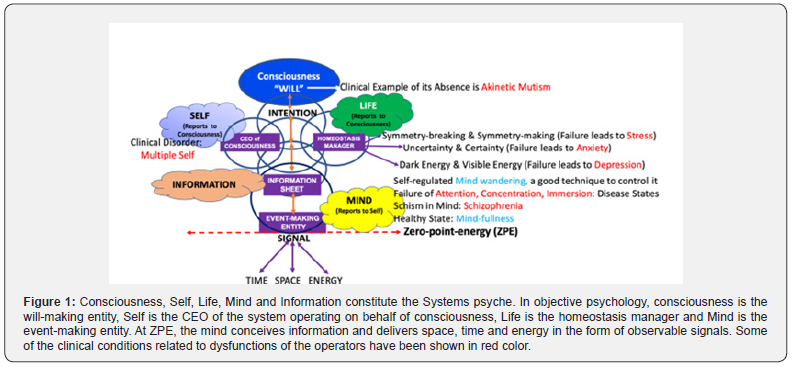
Exploring other Information States
Once the operators of the systems psyche are made objective, there are calls for explanation of their relationship with other information-states. Signal is the only observable information state. However, there are other information states as well. They have different names in our knowledge systems. Transformation of one state to another state of information happens in the terrain of systems psyche through four specific operations conducted by four specific operators, mind, self, life and consciousness [4-6], as shown in the Figure 3.
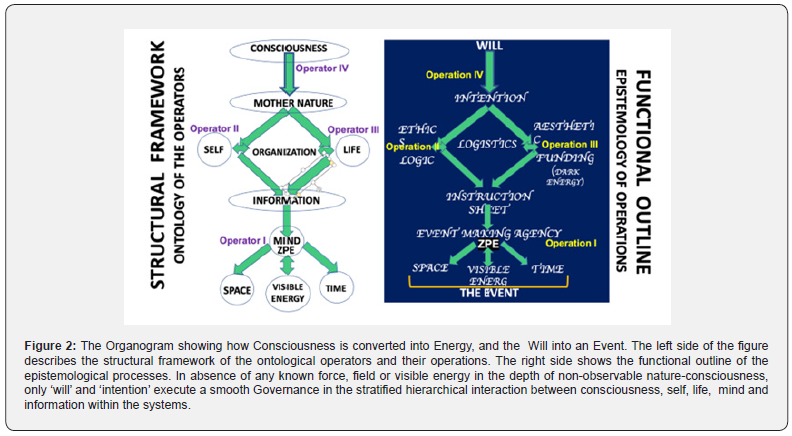
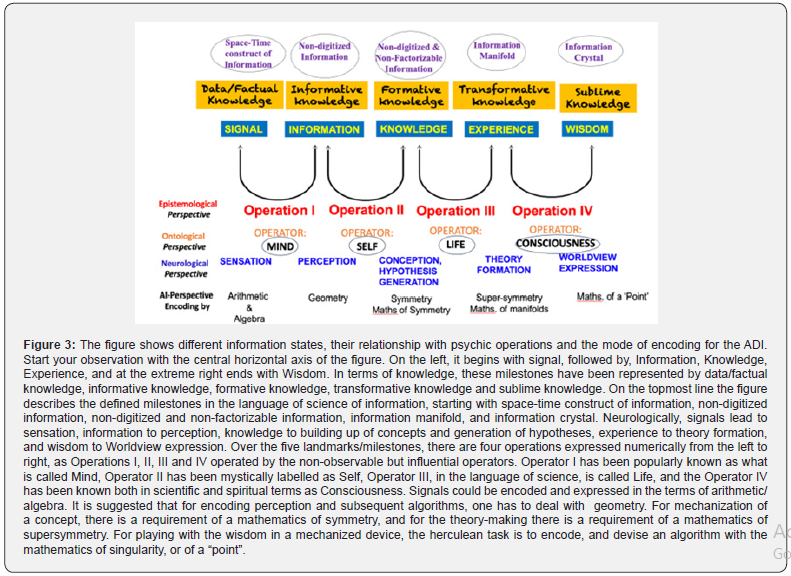
Harnessing dark energy
The transformation of different information-states within the system psyche has relation with harnessing of dark energy. As one climbs the ladder of cognition [6] from signal to nondigitized information, nondigitized information to an ensemble of nonfactorizable information and from there to information manifold and information crystal [4,5], there is consumption of visible tangible energy which is transformed into non-observable intangible dark energy. While climbing down the ladder, when the information crystal of wisdom breaks down step by step to a tangible signal, there is release of tangible energy from intangible dark energy. One can find a parallel of this phenomenon in protein folding and unfolding in cell biology [7-9] (Figures 4, 5).
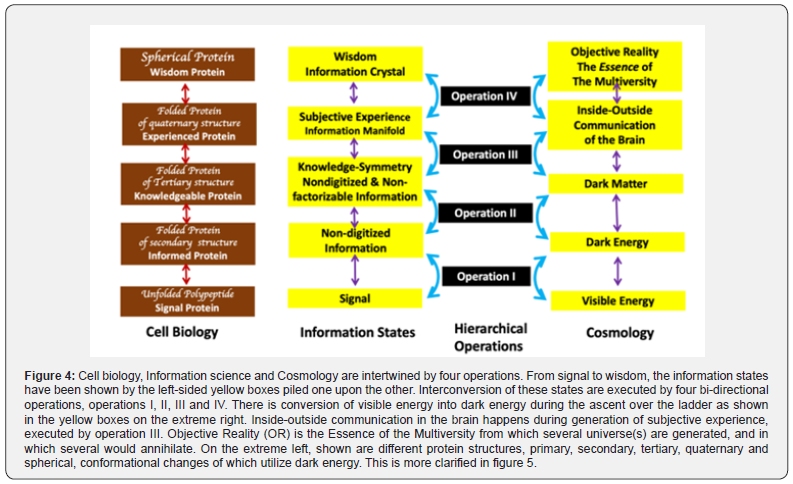
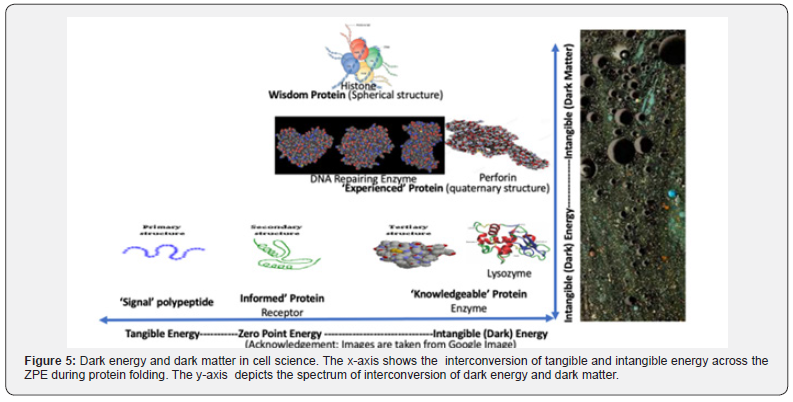
The present AI devices consume a huge amount of energy and contribute to environmental pollution. Can we invent any technology that harnesses dark energy through ZPE? Zero-point energy, Einstein’s cosmological constant, is the common pit where systems physics, systems psyche, systems biology and systems cosmology meet and transform into others [3]. Any one system may cross over to any three of the other systems through this zero-point energy state (Figure 6).
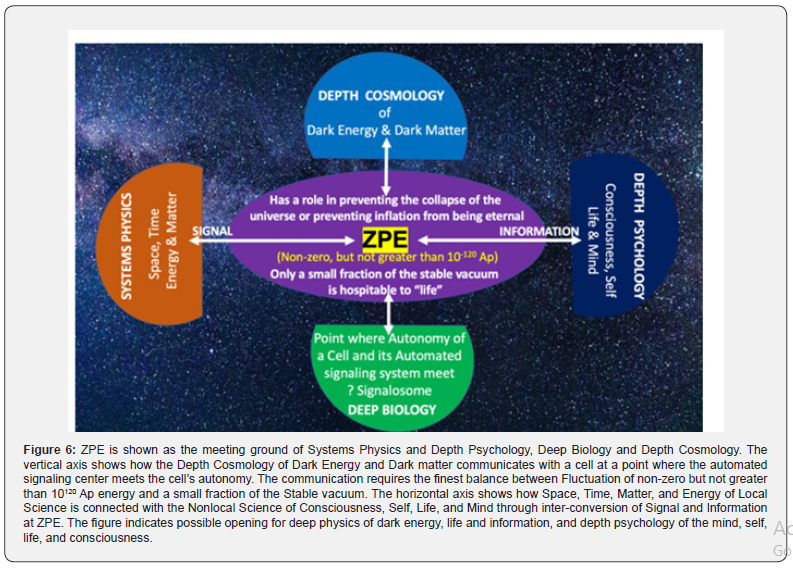
The author suggests that this problem of access to, and harnessing of dark energy could be approached in three ways; (i) to find out a few definite states of matter (e.g., matter in informed state and/or self-organizing state, and matter in its exotic superfluid and supersolid state, crystals with fluctuating ‘magnetic moment’, and matter with super-conductance property, and property of ability to process non-digitized information as for example, acellular slime mold), which all are closer to ZPE, and (ii) a syncytium of different matters that leads to ZPE [10] for their use in ADI and finally, (iii) exploring the possibility of dark energy being harnessed by biotechnology using microbes, algae, slimes, and bacteria. In fact, only “life” in its subtle form operates within the psyche, and in the 4-D world as we find it as life-form, has access to dark energy (Figure 7) [11]. Our task is to make an artificial device of intelligence that in its intact and operational state has access to ZPE. It is to operationally mechanize the art and science of the tasks of homeostasis manager namely homeostasis of uncertainty-certainty, symmetry-breaking and making, and the economics of intangible and tangible energy. This happens regularly in a biological cell.
Making AI Greener
Can any present humanoid AI make spontaneous responses subsequent to a signal-generated OTP (one time password), within a specified short span of time, as we human beings do? And, can ADI prove that it is not a robot by reading a captcha? The answer is, no! Why? ADI cannot generate short term memory. Why? The present AI works on signal-based (?)sensation! There is no generation of information-based perception. We need in the device more naturalization of consciousness so that the first step of transcendentalizing nature is made possible physically from signal to information, and in behavior from sensation to perception. In absence of some natural derivatives of consciousness, and without any flesh of cognition, how can any device adapt behaviorally with its surrounding environment?
How can we go about the question? By attempting to have more of biology within the device by; (i) use of materials used in construction of artificial brain, (ii) inclusion of astrocyte functions in neural network model for AI, (iii) use of organelles of biological cells in the chips, and (iv) incorporating natural protoplasm of cells or its synthetic equivalent within the circuits. The vital lifepart of a cell is this protoplasm. Biological cells are intelligent and have their own communicative language [12]. Besides electronic and electromagnetic communications, the cells communicate through molecules of peptides, folded proteins, spherical proteins, DNAs, RNAs, organelles and even through its protoplasm. The biological cell and its communication system offer enough lessons for influencing the future of AI [13]. How the cellular language system could be incorporated in the large language model (LLM) of the Artificial Device of Intelligence (ADI), where the device integrates different language systems, throws great challenges to the technologists. (v) Another fascinating technology in this context is necrobiotic, converting a dead material into a robot. Adding biology in the device will surely make it slow, error-prone, and often unpredictable. The trade-off in the combination is the production of a hybrid model, as required.
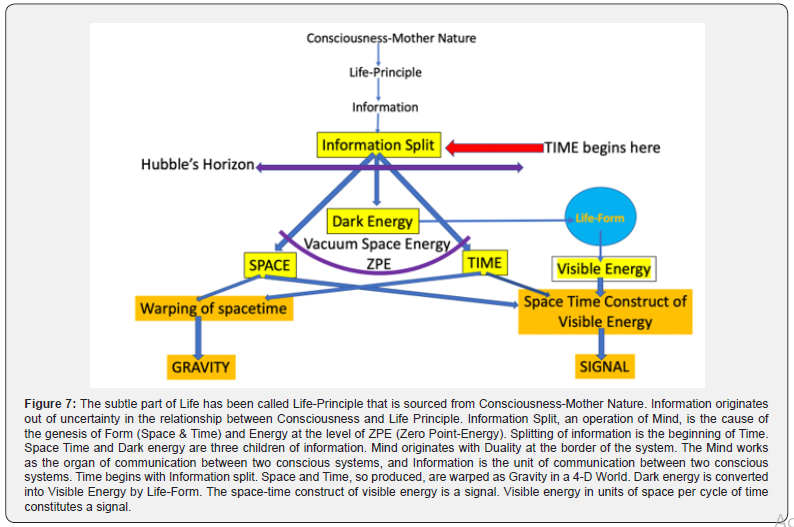
Binding ADI with Neutrino Technology
Neutrinos are the most common ‘wavicle’ of the universe, omnipresent, almost all-pervasive, with no charge, and no or little mass. They outnumber electrons and protons by about a billion to one. Wolfgang Pauli, ‘the living conscience of theoretical physics’ first predicted its existence in 1930. The science of neutrinos has developed to a reasonable state, but these apparently harmless and freshening neutrinos are yet to be harnessed in new technology. “Neutrinos in the current paradigm are thought to be particles of matter-dimension. Neutrinos in the new paradigm are thought to be particles of consciousness-dimension” (Shiuji Inomata, President, Japan Psychotronic Institute).
Neutrinos are affected by Weak Force and Gravity. Electrons can be generated from the interaction of Weak Force and neutrinos. Based on this, the author predicted in 1986 in the international conference on Living State in Shillong, India, production of a “brain-washing machine” should his supracervical consciousness [14] theory being taken seriously by scientists and technologists. The author also stated the brain-neutrino hypothesis in 2000 [15], and more concretely in 2012 [16].
Subject to approval of the Ethics Committee, before we apply this focused and directed beam of neutrinos on the brain, we might apply it on the programmed electron circuits of ADI for its directed manipulation. We could also experiment whether any synthetic plasm manufactured for the purpose of ADI can be churned and modified by focused directed neutrino beams?
Conclusions
We can conclude that we have a long way to travel. Humanized AI requires some flesh and mind to be added to the present ADI. From dream to reality there exists a path less travelled by. The paper is rich in propositional contents for this journey. It calls for an interdisciplinary dialogue between deep strategic thinkers, concerned academics of physical, psychological, biological and cosmological science, and surely involving the technologists and the corporate industrialists. To wed adorably a good science with a good technology in consonance with the emerging Worldview that accommodates Science, Humanity and Spirit, the job has been divided into big and small tasks in which several PhD-seeking scholars could start their work ensuring growth of Academics and scholarships. Such attempts will make the industry more innovative, less concentrated, and more competitive. Science of consciousness would strengthen the required attitude guided by conscience and honesty with ethics and aesthetics. Adequate care must be taken that the natural gift of the power of cognitive thinking to humanity is never compromised, economic and social divides amongst aspirants are narrowed down by hierarchical cooperation amongst them, and the attempts for deep fakes are nipped in the bud. The regulatory body must ensure that technoterrorism, information terrorism, and bioterrorism could never be sponsored through such devices by any Head of the State or multi-billionaire industrialist. For keeping the future of Humanity as well as of the technology rest secured, this extraordinary journey for developing Humanized AI needs to be supported by concurrent growth of the science for consciousness (spirituality), and the science of consciousness (mysticism). The decision for exemplary weddings are made and supervised from heaven (Consciousness).
References
- Mukhopadhyay AK (2023) The Mystery of Memory: No “Life”, No Memory. World J Psychiatry Ment Health Res 6(1): 1035.
- Mukhopadhyay AK (2016) Systems Psyche: Its Structure, Operation and Possible Molecular Links. Psychol Behav Sci Int J 1(3): 555565.
- Mukhopadhyay AK (2022) Einstein’s Abandoned Otherworld: How Conscious “Will” Manifests in a 4-D World? EC Psychology and Psychiatry 11(5): 01-08.
- Mukhopadhyay AK (2021). Science of Information. Global Journal of Science Frontier Research: A Physics and Space Science, 21(1) 1(0): 15-30.
- Mukhopadhyay AK, Mukhopadhyay AS (2019) Visualizing Information as a Dynamic Entity Roadmap of Deep Science, AI and Humanity. Psychol Behav Sci Int J 13(4): 555867.
- Mukhopadhyay AK (2017) The Ladder of Cognition: Abstract Operation, Molecular Biology, Systems Science. Ann Psychiatry Ment Health 5(4): 1107.
- Mukhopdhyay AK (2018) Cognitive Canvas: Molecular Embroidery, Fabric and the Base. EC Psychology and Psychiatry 7(7): 428-439.
- Mukhopadhyay AK (2020) Deep Neuroscience: The Way the Brain needs to be looked into (2020). Journal of Neurology and Brain Research 1: 001-006.
- Mukhopadhyay AK (2023) The Source and the Genesis: In the Language of Science. EC Psychology and Psychiatry 12.1: 29-43.
- Mukhopadhyay AK (2020) Life-Form A Matters-Syncytium: Deep Science for Matter Correlates of Conscious States. EC Psychology and Psychiatry SI.02: 01-16.
- Mukhopadhyay AK (2020) Deep Science of Cosmo Neurology. The Multiverse and The Supracortical Consciousness. J Neurosurg Imaging Techniques 6(3): 347-366.
- Ji S. The Cell Language Theory (2018) World Scientific Publishing Europe Ltd. London.
- Mukhopadhyay AK, Kumar V, Singh A, Ranjan M, Mukhopadhyay T, et al. (2023) Future of AI: The Cell shows the Way. Austin J Clin Pathol 10(1): 1079.
- Mukhopadhyay AK (1985) States of Consciousness, a Holistic Hypothesis. Supracortical Consciousness, an Existing Reality. In, The Frontiers of Research in Human Biology. Conscious Publications. New Delhi, pp. 1-6.
- Mukhopadhyay AK (2000) The Millennium Bridge. Conscious Publications Delhi, pp. 164-168.
- Mukhopadhyay AK (2012) Information Holograph. The Structure, the Source and its Operation International Journal of Bioengineering, Neurosciences and Technology 2(2): 12-32.






























